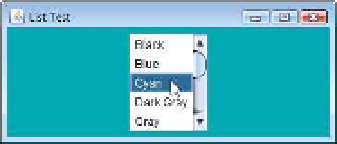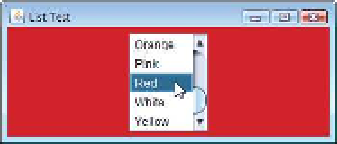Java Reference
In-Depth Information
5
public
class
ListTest
6
{
7
public
static
void
main(String[] args)
8
{
9
ListFrame listFrame =
new
ListFrame();
// create ListFrame
10
listFrame.setDefaultCloseOperation(
JFrame.EXIT_ON_CLOSE
);
11
listFrame.setSize(
350
,
150
);
12
listFrame.setVisible(
true
);
13
}
14
}
// end class ListTest
Fig. 12.24
|
Selecting colors from a
JList
. (Part 2 of 2.)
Line 29 (Fig. 12.23) creates
JList
object
colorJList
. The argument to the
JList
constructor is the array of
Object
s (in this case
String
s) to display in the list. Line 30 uses
JList
method
setVisibleRowCount
to determine the number of items
visible
in the list.
Line 33 uses
JList
method
setSelectionMode
to specify the list's
selection mode
.
Class
ListSelectionModel
(of package
javax.swing
) declares three constants that specify
a
JList
's selection mode—
SINGLE_SELECTION
(which allows only one item to be selected
at a time),
SINGLE_INTERVAL_SELECTION
(for a multiple-selection list that allows selection
of several contiguous items) and
MULTIPLE_INTERVAL_SELECTION
(for a multiple-selection
list that does not restrict the items that can be selected).
Unlike a
JComboBox
, a
JList
does not
provide a scrollbar
if there are more items in the
list than the number of visible rows. In this case, a
JScrollPane
object is used to provide
the scrolling capability. Line 36 adds a new instance of class
JScrollPane
to the
JFrame
.
The
JScrollPane
constructor receives as its argument the
JComponent
that needs scrolling
functionality (in this case,
colorJList
). Notice in the screen captures that a scrollbar cre-
ated by the
JScrollPane
appears at the right side of the
JList
. By default, the scrollbar
appears only when the number of items in the
JList
exceeds the number of visible items.
Lines 38-49 use
JList
method
addListSelectionListener
to register an object that
implements
ListSelectionListener
(package
javax.swing.event
) as the listener for the
JList
's selection events. Once again, we use an instance of an anonymous inner class (lines
39-48) as the listener. In this example, when the user makes a selection from
colorJList
,
method
valueChanged
(line 42-47) should change the background color of the
List-
Frame
to the selected color. This is accomplished in lines 45-46. Note the use of
JFrame
method
getContentPane
in line 45. Each
JFrame
actually consists of
three layers
—the
background
, the
content pane
and the
glass pane
. The content pane appears in front of the
background and is where the GUI components in the
JFrame
are displayed. The glass pane
is used to display tool tips and other items that should appear in front of the GUI compo-
nents on the screen. The content pane completely hides the background of the
JFrame
;
thus, to change the background color behind the GUI components, you must change the
content pane's background color. Method
getContentPane
returns a reference to the




